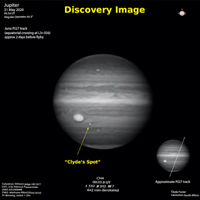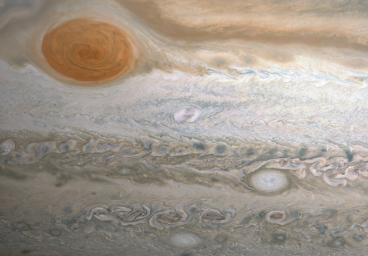
Figure B
Click on image for larger versionThis image from NASA's Juno spacecraft captures several storms in Jupiter's southern hemisphere (main image). Some of these storms, including the Great Red Spot at upper left, have been churning in the planet's atmosphere for many years, but when Juno obtained this view of Jupiter, the smaller, oval-shaped feature at the center of the image was brand new.
The new feature was discovered by amateur astronomer Clyde Foster of Centurion, South Africa. Early on the morning of May 31, 2020, while imaging Jupiter with his telescope, Foster noticed a new spot, which appeared bright as seen through a filter sensitive to wavelengths of light where methane gas in Jupiter's atmosphere has strong absorption. The spot was not visible in images captured just hours earlier by astronomers in Australia.
On June 2, 2020, just two days after Clyde Foster's observations, Juno performed its 27th close flyby of Jupiter. The spacecraft can only image a relatively thin slice of Jupiter's cloud tops during each pass. Although Juno would not be traveling directly over the outbreak, the track was close enough that the mission team determined the spacecraft would obtain a detailed view of the new feature, which has been informally dubbed "Clyde's Spot."
The feature is a plume of cloud material erupting above the upper cloud layers of the Jovian atmosphere. These powerful convective "outbreaks" occasionally erupt in this latitude band, known as the South Temperate Belt (JunoCam observed another outbreak at this latitude back on Feb. 7, 2018).
Figure B shows Jupiter as captured by Foster's telescope, and the Juno spacecraft's approximate trajectory as it zoomed close by the planet, traveling from north to south.
Another citizen scientist, Kevin M. Gill, created the main image using data from Juno's JunoCam instrument. This view is a map projection that combines five JunoCam images taken on June 2, 2020, between 3:56 a.m. PDT (6:56 a.m. EDT) and 4:25 a.m. PDT (7:25 a.m. EDT). At the time the images were taken, Juno was between about 28,000 miles (45,000 kilometers) and 59,000 miles (95,000 kilometers) from the planet's cloud tops at latitudes of between about 48 degrees and 67 degrees south.
JunoCam's raw images are available for the public to peruse and process into image products at
https://missionjuno.swri.edu/junocam/processing.
More information about Juno is at http://www.nasa.gov/juno and http://missionjuno.swri.edu.

 Planetary Data System
Planetary Data System













